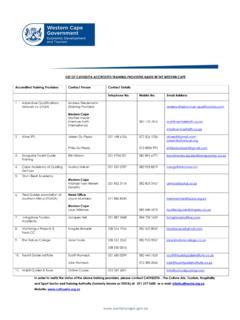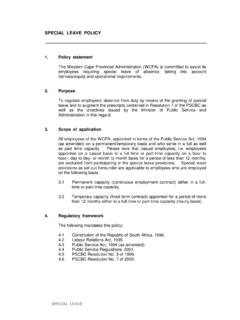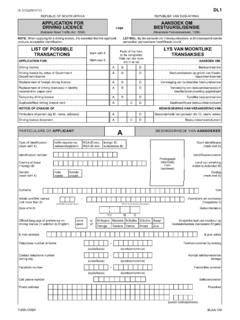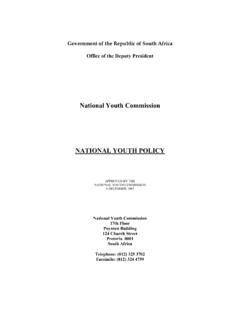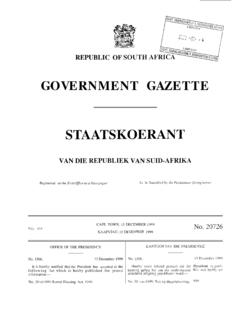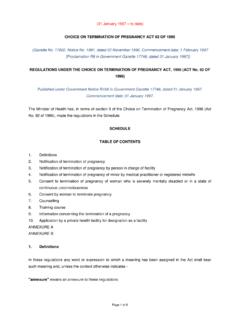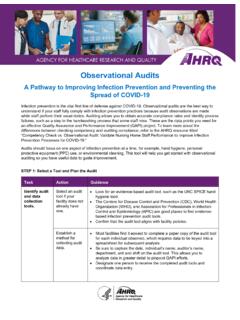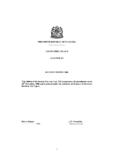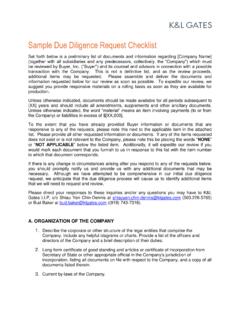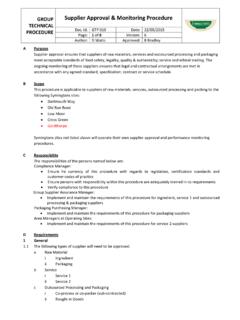Transcription of Annual Report Guide for Schedule 3A and 3C ... - Western Cape
1 Annual Report Guide for Schedule 3A and 3C Public Entities The Annual Report Guide Schedue 3A and 3C Public Entities 2 TABLE OF CONTENTS 1. Introduction .. 4 Purpose of Annual reports .. 4 Purpose of the Guide .. 4 How to use the Guide .. 4 Applicability of the Guide .. 5 Other matters to consider when applying the 5 Documents to be used in preparing the Annual Report .. 6 Responsibilities for compiling the Annual Report .. 6 Submission dates for the Annual Report .. 6 Legislation .. 7 Acronyms and icons used in this document .. 8 2. Annual Report .
2 9 Cover .. 9 Table of Contents .. 9 Part A: General Information .. 10 Public entity s general information .. 10 List of Abbreviations /Acronyms (if applicable) .. 10 Foreword by the Chairperson .. 10 Chief Executive Officer s Overview .. 11 Statement of responsibility and confirmation of the accuracy of the Annual Report 11 Strategic Overview .. 12 Legislative and Other Mandates .. 12 Organisational Structure .. 12 Part B: Performance 13 Auditor-General s Report : Predetermined Objectives .. 13 Situational analysis .. 14 Strategic Outcome Oriented Goals.
3 15 Performance information by programme/activity/objective .. 15 Revenue collection .. 17 Capital investment .. 18 Part C: Governance .. 19 Introduction .. 19 Portfolio Committees .. 19 Executive Authority .. 19 The Accounting Authority/The Board .. 19 Risk Management .. 22 The Annual Report Guide Schedue 3A and 3C Public Entities 3 Internal Control Unit .. 22 Internal Audit and Audit Committees .. 22 Compliance with laws and regulations .. 22 Fraud and Corruption .. 22 Minimising Conflict of Interest .. 23 Code of Conduct .. 23 Health, Safety and Environmental Issues.
4 23 Company Secretary (if applicable) .. 23 Social Responsibility .. 23 Audit Committee Report .. 23 Part D: Human Resource Management .. 25 Introduction .. 25 Human Resources Oversight Statistics .. 25 Part E: Financial Information .. 30 Report of the External Auditor .. 30 Annual Financial Statements .. 30 3. Annexures .. 31 Annexure A: Statement of responsibility and confirmation of accuracy .. 31 Annexure B: Report of the Audit Committee .. 33 Annexure C: Specimen of the Annual Report .. 34 The Annual Report Guide Schedue 3A and 3C Public Entities 4 1.
5 Introduction This section is for information purposes only and it must not be included in the actual Annual Report of the public entity, please refer to the specimen. Purpose of Annual reports Annual reports are an integral part of public entities reporting. The achievements, performance information, outlook, financial position and human resources information of public entities for each reporting period are reported in the Annual Report . The information reported on in the Annual Report include the actual achievements for the reporting period in relation to the planned targets and budgets as published in the strategic plan, Annual performance plan and budget documents.
6 Annual reports are tabled in Parliament/Legislatures and it is available to the general public. The publishing of financial and non-financial information of public entities is essential for accountability and, transparency and to improve trust and confidence in government service delivery. The reported information must be accurate and balanced, reporting both the successes and explaining the shortcomings. Ultimately the characteristics of a quality Annual Report are that it: complies with statutory and policy requirements. presents information (both positive and negative) in an understandable and concise manner.
7 Purpose of the Guide The Guide provides guidance on the non-financial information requirements of the Annual Report . In other words, the guidance is on all sections of the Annual Report except the Annual Financial Statements (AFS) section. The AFS section is dealt with in a separate Guide that is applicable to the legal form of the public entity. The Annual Report Guide is supplemented by a specimen for Annual reports, which a public entity should use to assist in the preparation of the Annual Report . Adherence to the format of this Guide will enhance public entities coverage of all aspects of their activities and financial performance, and will promote ease of reference and comparison for users of the Annual Report .
8 How to use the Guide Section 1, Introduction, of this Guide provides guidance and clarity with regard to legislation that govern Annual reports and general information about Annual reports and the framework of this Guide . Section 2, Annual Report , of this Guide provides public entities with the format of the Annual Report , structure; details and information that public entities need to comply with in their Annual reports. Each heading that needs to be disclosed in the Annual Report has 2 sub-headings in the Guide . The 1st sub-heading is the guideline which provides the guidance on the information to be reported on.
9 The 2nd sub-heading is the Format of disclosure which indicates how the information must be presented in the Annual Report . Section 3, Annexures, contains the format of letters and reports that need to be completed by the respective officials and some of these reports are published in the public entity s Annual Report . A specimen of the Annual Report of a public entity is also included, as Annexure C. The Annual Report Guide Schedue 3A and 3C Public Entities 5 Applicability of the Guide This Guide applies to all Schedule 3A and 3C public entities, as listed in the PFMA All other public entities will utilise their own formats, however if these public entities do not have a format, they could utilise this format as a Guide .
10 Public entities are classified into different schedules based on their nature and level of autonomy. A brief review is provided below. Schedule 2 Schedule 2 entities are referred to as the major public entities and are intended to generate profits and declare dividends. These entities have the most autonomy of all the public entities, as they operate in a competitive marketplace and are run in accordance with general business principles. In terms of section 66(3)(a) of the PFMA, Schedule 2 public entities may also borrow money through the accounting authority of that entity, which implies that they also have extensive borrowing powers.


